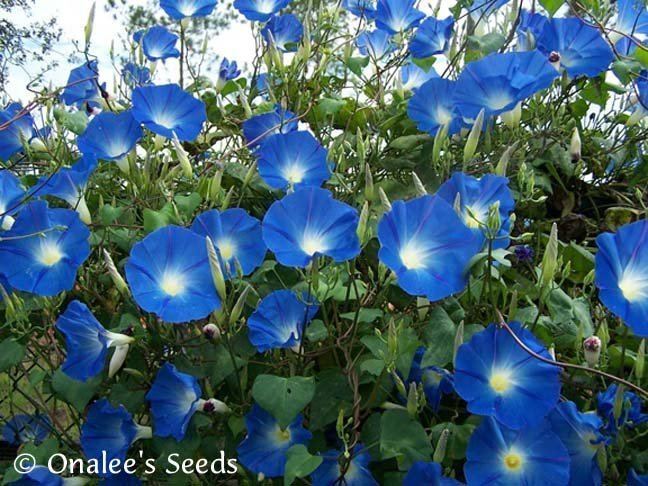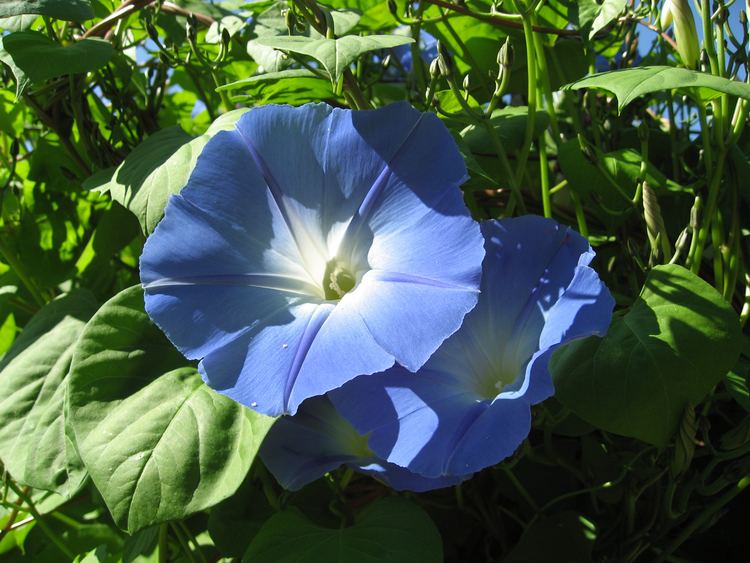Rank Species | Genus Ipomoea Higher classification Ipomoea | |
 | ||
Similar Ipomoea, Ipomoea purpurea, Ipomoea violacea, Convolvulaceae, Tropical white morning‑glory | ||
Santana moonflower morning glory ipomoea tricolor purpurea
Ipomoea tricolor (grannyvine or morning glory) is a species of flowering plant in the family Convolvulaceae, native to the New World tropics, and widely cultivated and naturalised elsewhere. It is an herbaceous annual or perennial twining liana growing to 2–4 m (7–13 ft) tall. The leaves are spirally arranged, 3–7 cm long with a 1.5–6 cm long petiole. The flowers are trumpet-shaped, 4–9 cm (2–4 in) in diameter, most commonly blue with a white to golden yellow centre.
Contents
- Santana moonflower morning glory ipomoea tricolor purpurea
- Cultivation and uses
- Entheogenic use
- References

Cultivation and uses

In cultivation, the species is very commonly grown misnamed as Ipomoea violacea, actually a different though related species. Numerous cultivars of I. tricolor with different flower colours have been selected for use as ornamental plants; widely grown examples include Blue Star, Flying Saucers, Heavenly Blue, Heavenly Blue Improved, Pearly Gates, Rainbow Flash, Skylark, Summer Skies and Wedding Bells. The cultivar 'Heavenly Blue' has gained the Royal Horticultural Society's Award of Garden Merit.
Entheogenic use

The seeds, vines, flowers, and leaves contain ergoline alkaloids, and have been used for centuries by many Mexican Native American cultures as an entheogen; R. Gordon Wasson has argued that the hallucinogenic seeds used by the Aztecs under the Nahuatl name tlitliltzin, were the seeds of I. tricolor. Wasson also noted that the Zapotecs of Oaxaca know the seeds as badoh negro.

Richard Schultes in 1941 described Mexican Native American use in a short report documenting the use dating back to Aztec times cited in TiHKAL by Alexander Shulgin. Further research was published in 1960, when Don Thomes MacDougall reported that the seeds of Ipomoea tricolor were used as sacraments by certain Zapotecs, sometimes in conjunction with the seeds of Rivea corymbosa, another species which has a similar chemical composition, with lysergol instead of ergine. This more widespread knowledge has led to a rise in entheogenic use by people other than Native Americans.
The hallucinogenic properties of the seeds are usually attributed to ergine (also known as d-lysergic acid amide, or LSA), although the validity of the attribution remains disputed. Lysergic acid hydroxyethylamide and ergonovine are also considered to be contributing psychedelic alkaloids in the plant. While ergine is listed as a Schedule III substance in the United States, parts of the plant itself are not controlled, and seeds and plants are still sold by many nurseries and garden suppliers.
The seeds also contain glycosides, which may cause nausea if consumed.
